#domestication
Text

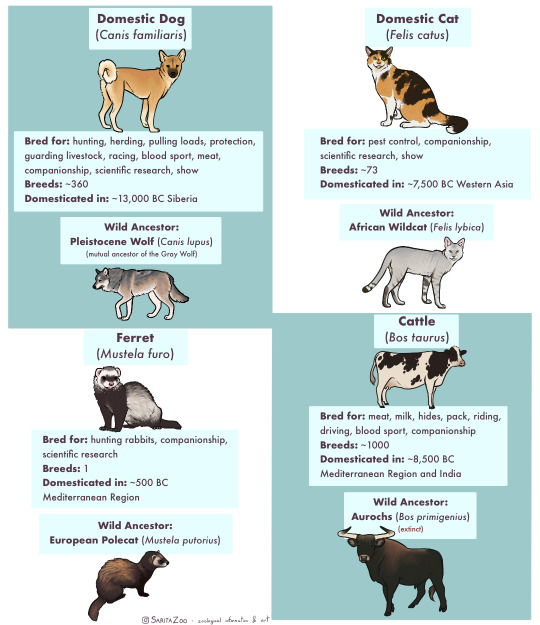


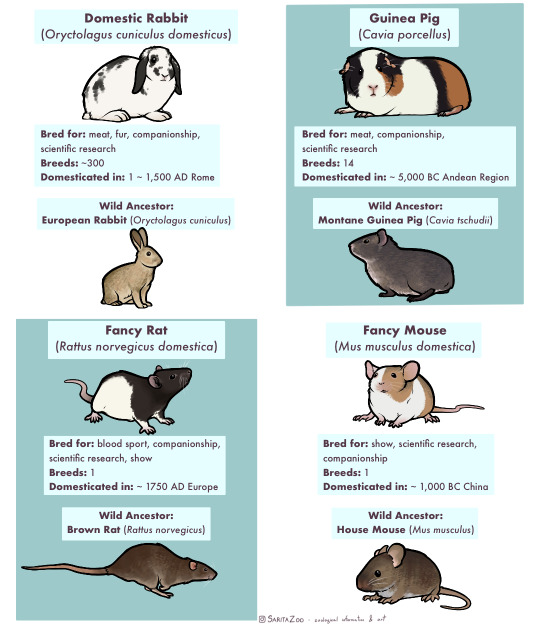
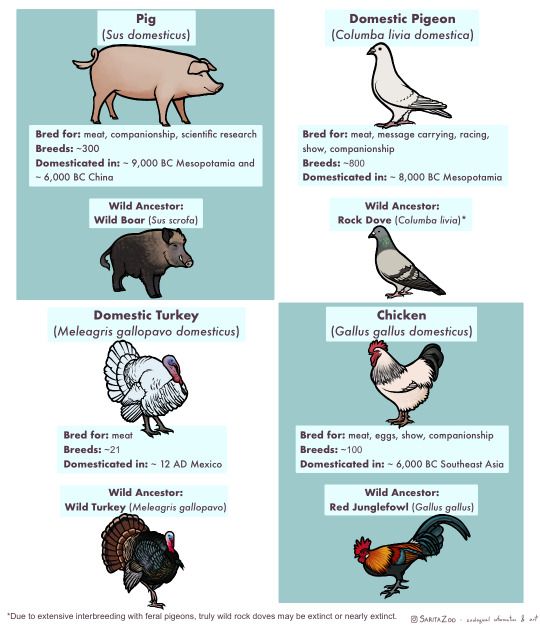
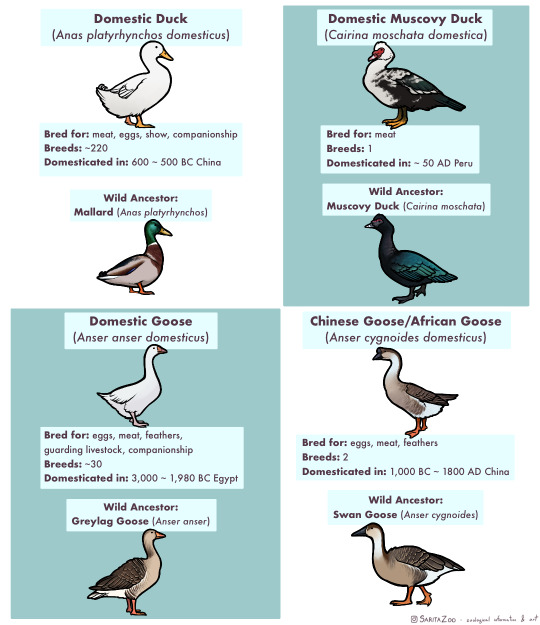
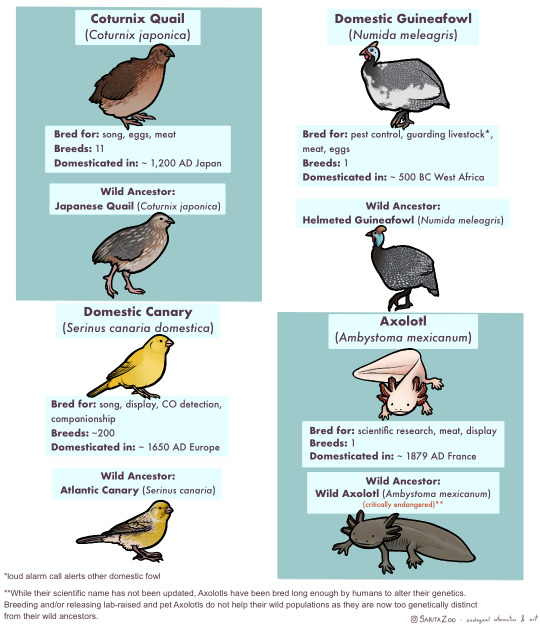


Phew. This one took, uh… a bit longer than expected due to other projects both irl and art-wise, but it’s finally here. The long-awaited domestic animal infographic! Unfortunately, I didn’t have enough space to cover every single domestic animal (I’m so sorry, reindeer and koi, my beloveds) but I tried to include as many of the “major ones” as possible.
I made this chart in response to a lot of the misunderstandings I hear concerning domestic animals, so I hope it’s helpful!
Further information I didn’t have any room to add or expand on:
🐈 “Breed” and “species” are not synonyms! Breeds are specific to domesticated animals. A Bengal Tiger is a species of tiger. A Siamese is a breed of domestic cat.
🐀 Different colors are also not what makes a breed. A breed is determined by having genetics that are unique to that breed. So a “bluenose pitbull” is not a different breed from a “rednose pitbull”, but an American Pitbull Terrier is a different breed from an American Bully! Animals that have been domesticated for longer tend to have more seperate breeds as these differing genetics have had time to develop.
🐕 It takes hundreds of generations for an animal to become domesticated. While the “domesticated fox experiment” had interesting results, there were not enough generations involved for the foxes to become truly domesticated and their differences from wild foxes were more due to epigenetics (heritable traits that do not change the DNA sequence but rather activate or deactivate parts of it; owed to the specific circumstances of its parents’ behavior and environment.)
🐎 Wild animals that are raised in human care are not domesticated, but they can be considered “tamed.” This means that they still have all their wild instincts, but are less inclined to attack or be frightened of humans. A wild animal that lives in the wild but near human settlements and is less afraid of humans is considered “habituated.” Tamed and habituated animals are not any less dangerous than wild animals, and should still be treated with the same respect. Foxes, otters, raccoons, servals, caracals, bush babies, opossums, owls, monkeys, alligators, and other wild animals can be tamed or habituated, but they have not undergone hundreds of generations of domestication, so they are not domesticated animals.
🐄 Also, as seen above, these animals have all been domesticated for a reason, be it food, transport, pest control, or otherwise, at a time when less practical options existed. There is no benefit to domesticating other species in the modern day, so if you’ve got a hankering for keeping a wild animal as a pet, instead try to find the domestic equivalent of that wild animal! There are several dog breeds that look and behave like wolves or foxes, pigeons and chickens can make great pet birds and have hundreds of colorful fancy breeds, rats can be just as intelligent and social as a small monkey (and less expensive and dangerous to boot,) and ferrets are pretty darn close to minks and otters! There’s no need to keep a wolf in a house when our ancestors have already spent 20,000+ years to make them house-compatible.
🐖 This was stated in the infographic, but I feel like I must again reiterate that domestic animals do not belong in the wild, and often become invasive when feral. Their genetics have been specifically altered in such a way that they depend on humans for optimal health. We are their habitat. This is why you only really see feral pigeons in cities, and feral cats around settlements. They are specifically adapted to live with humans, so they stay even when unwanted. However, this does not mean they should live in a way that doesn’t put their health and comfort as a top priority! If we are their world, it is our duty to make it as good as possible. Please research any pet you get before bringing them home!
#SaritaZoo#my art#domestic animals#domestication#pets#dogs#cats#ferrets#cows#sheep#goats#bovids#horses#donkeys#camels#llamas#alpacas#rabbits#guinea pigs#rats#pet rats#pet mice#pigs#pigeons#turkeys#chickens#ducks#geese#quail#i ran out of tags rip
31K notes
·
View notes
Text
A study that just came out demonstrates that outdoor cats are known to prey on over two thousands species of wild animal, from mammals to birds to insects. That includes 347 species that are endangered, threatened or otherwise of concern, and they've been a key factor of the permanent extinction of over 60 species. And while cats may not always bring home what they catch, chances are if your cat is allowed to roam unsupervised outside, they're killing your local wildlife.
Why is this so important? Worldwide, wild animal populations have decreased in number by 69% in the past fifty years; that means that in my lifetime (born in 1978), the sheer number of wild animals in the world has been decreased by over half. Even "common" wild species are less numerous than before. While habitat population is the single biggest cause of species endangerment and extinction overall, outdoor and indoor/outdoor cats are a significant cause as well. In fact, they are the single biggest cause of human-caused mortality in wild birds.
Most importantly, it's very, very simple to fix this problem: keep your cats indoors, and spay and neuter them. If your cat is bored, they need more enrichment, and there are plenty of ways to make your home more exciting for them, from bringing home cardboard boxes for them to explore, to playing with them more often. If you want your cat to get some outdoor enrichment, leash train them (yes, it can be done!) If you have the space and resources, build them a catio where they can be safe from outdoor dangers like predators and cars, while also keeping local wildlife safe from them.
If you just give into their whining and pawing at the door, then they know that that's what they have to do to get their way; I know it's a tough transition, but it's worth it in the end for everyone involved. Cats are domesticated, which means they are not native anywhere in the world; there are exactly zero ecosystems in which they belong, save for the safety of your home. It is your responsibility to give them an enriching environment without taking the shortcut of letting them go wreak havoc outside.
#cats#outdoor cats#feral cats#nature#wildlife#animals#ecology#environment#conservation#science#scicomm#birds#endangered species#extinction#domesticated animals#domestication#biology#animal behavior#animal welfare
8K notes
·
View notes
Text
I looked up some stuff about the "domestication syndrome" in animals because I read a couple times in books the idea that domesticated animals are neotenous, meaning they retain juvenile traits into adulthood. The idea being that humans have essentially created more helpless, more exploitable versions of wild animals to "dominate" and abuse nature.
I thought, "Okay, that sounds like something that couldn't be proven. How much do we even know about the juvenile brain development of, say, wild goats or boars, anyway?"
So I found this review of the literature that goes back to the fur farm fox domestication study and it's even worse than I thought: We don't even know that a 'domestication syndrome' in animals exists at all, let alone whether it is a retention of juvenile traits into adulthood.
So the fur farm fox domestication study: you may have heard of it, it claimed to have demonstrated that within a few generations, by selecting for tameness, the researchers bred "domesticated" foxes with a whole suite of traits that appear in many domesticated animals but seem unrelated to tameness, such as piebald coloration and floppy ears. The idea is that the genes for tameness and for these other traits commonly seen in domestic animals are linked, that is, an animal that inherits one is likely to inherit the other.
There's some major problems. First of all, all the foxes used in the study were from fur farms, and had already been selected for some level of docility and for coat color variation. The foxes didn't get white spots on them because they were selected for tameness, instead the pre-existing population they were selected from had those genes in it to begin with. Also, the effective population size of the foxes in the study was pretty small, meaning a small amount of genetic drift could have a big impact.
Second, there isn't very much evidence for most of the "domestication syndrome" traits in most animals. Even where the "domestication syndrome" traits can be found, they are often particular to specific breeds, and it's unclear whether they are linked to domestication as such or just the development of that specific breed.
This study only deals with a few animals, mostly small animals. It would be even more interesting to see a breakdown of even more animals (particularly more large animals). Off the top of my head, almost none of these would apply to horses, and only in specific cases would apply to cattle. Even in dogs, extreme changes in skull morphology have happened relatively recently with breeders in modern times going after extreme phenotypes.
Particular to cats: extreme skull changes and floppy ears occur as part of some "breeds" because they are specific painful genetic disorders that breeders of cats decided to perpetuate VERY recently. Scottish Folds were deliberately developed from cats that just so happened to have a disease that causes them to be in constant suffering due to their messed up joints, it's not just a variation that regularly pops up in cats to varying extents. Likewise with the smushed-face Persians. Their brains are getting squished into where their spinal cords should go because their skulls are so messed up from selective breeding for an extreme look.
What domestication means has been majorly shaken up in the past hundred years. With companion animals, breeders are in a race to make the most screwed up animal with the most extreme, striking traits possible, and with livestock animals, lots of heritage breeds with more variations have straight up gone extinct because they've been flattened into industrial monocultures to produce meat and milk as efficiently as possible, health and genetic diversity be damned.
To study domestication itself, you would have to study landrace breeds, right?
Basically there isn't one thing that domestication is
3K notes
·
View notes
Text


Domestication is a hell of a drug.
Shop
2K notes
·
View notes
Text

A number of different varieties of potatoes at the International Potato Center in Peru showcases the enormous diversity in just one plant. Scientists at McGill University in Montreal have sequenced the DNA of nearly 300 types of potatoes, including wild varieties, to create a “super pangenome” — a species’ entire set of genes.
374 notes
·
View notes
Text
thinking about mechta (dream) the first of the domesticated foxes to have floppy ears
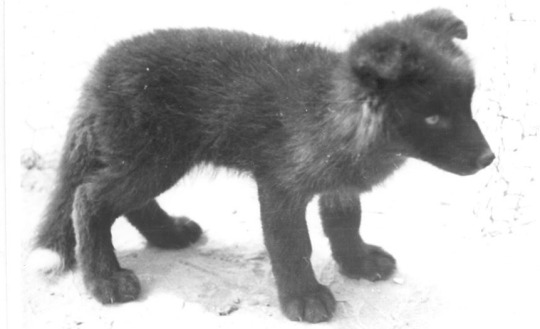
“In 1969, the 10th generation of foxes was born, and among them was a pup that she named Mechta, the Russian word for dream. In wild foxes, a pup’s ears are floppy until it is about two weeks old, at which point its ears take on the ramrod-straight look we tend to picture when we think of foxes. When Mechta was three weeks old, her ears had not yet straightened. They still hadn’t at four weeks, nor at five. Mechta looked exactly like a dog pup.”
#not stamping approval or whatever it’s honestly more unsettling like a horror reveal that the same must’ve happened with wolves#lyudmila trut#fox#foxes#canid#vulpes vulpes#domestic fox#domestication#animals#silver fox#fave
823 notes
·
View notes
Text
Time Travel Question 16: Ancient History VII and Earlier
These Questions are the result of suggestions from the previous iteration.
This category may include suggestions made too late to fall into the correct grouping.
Please add new suggestions below if you have them for future consideration.
I am particularly in need of more specific non-European suggestions in particular, but all suggestions are welcome.
#Time Travel#Morocco#Phoenicia#The Mediterranean#The Xia Dynasty#Pompeii#Domestication#Agricultural Revolution#Finish history
317 notes
·
View notes
Text
Look, hear me out, just, gimme a chance:
We should domesticate Raccoons.
460 notes
·
View notes
Photo

The domestication of plants in the neolithic.
by LegendesCarto
200 notes
·
View notes
Text
I feel sorry for pigeons. We domesticated them, and then one day said, “Nevermind, you’re not fashionable anymore.” Like I feel like if you make an animal dependent on humans you shouldn’t be mad when they poop all over everything when they’re neglected.
92 notes
·
View notes
Text
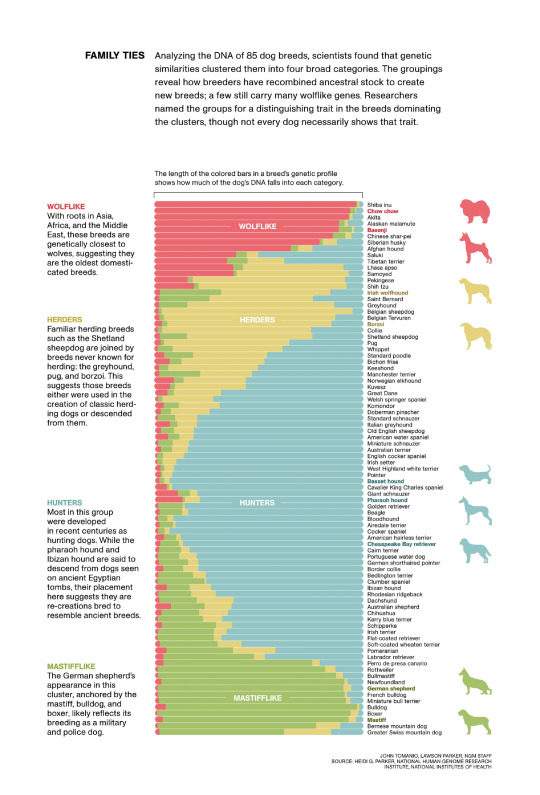
The Four Broad Groups Of Dogs: A Genetic Study Of 85 Breeds
#infographics#fun facts#fun fact#dogs#wolves#domestication#biology#graphs#interesting#fascinating#genetics
126 notes
·
View notes
Link
Domesticated parrots that learned to initiate video chats with other pet parrots had a variety of positive experiences, such as learning new skills, researchers from Northeastern University, the University of Glasgow and MIT report this month in Proceedings of the 2023 CHI Conference on Human Factors in Computing Systems...
#animals#biology#birds#land birds#new research#domestication#pets#parrot#bird#parrots#animal welfare#animal intelligence#animal behavior
176 notes
·
View notes
Note
I've seen claims that leopard geckos are the first domesticated lizard, I'm pretty skeptical of that though. What are your thoughts on it?
Depends on if you're using the popular or actual definition of domestication.
A lot of people think "domestication" is a lot more simple than it actually is, more along the lines of "tame." If you're going by leopard geckos being easily tamed, easily bred in captivity, and being good pets in general, then sure.
If you're going by the actual definition, though - domestication is a process that takes thousands of years, and requires an animal to evolve alongside humans in ways that substantially change them - then no, not even close. Leopard geckos are still fundamentally wild animals.
186 notes
·
View notes
Text
I believe I have consumed too much HDG literature.
My dommy mannerisms are turning into an affini's, to the point I genuinely used "mulch" as a swear word >.>
See me in 4-6 months where my hands have bacame drug injectors and I can't stop talking about my "floret" like they're the cutest thing to ever exist (they are)
24 notes
·
View notes
Text
Spectember D8: Artificial selection

66 million years ago an extraterrestrial object landed on earth… not collided… landed.
It was itself artificial in nature, intelligent, very large and ready to prepare this world for occupants that were never going to come here, this machine was throw by an already extinct civilization that was colonizing the galaxy millions of years ago, leaving these behemoth terraforming drones that readjust the biosphere of a whole planet to be turned into a Arcology structured Ecumenopolis which can let them colonize the new alien planet. The artificial construct is not high intelligent, is more automatic than anything so this would only keep going for what was programmed without the ability to learn anything more of what it needs to maintain the global Arcological cities on the end cretaceous earth, even if it remains millions of years on the same task, following the same protocols and only adapting to an extend.
This has turned the history of earth into a new age, one where a civilization formed without its residents, now affecting the biosphere of the late cretaceous earth and carrying it into a strange new period, this causing a transformation on ways that benefited the survival of no avian dinosaurs and other animals and plants that could have perished if the asteroid collided as this whole system would protect them of the asteroid impact as part of its protocol of preservation. However, the existence of this artificial being would shape that fauna in ways that only could rival to changes made by geological and climate events, the machine would focus its goal on trying to adjust the animals that now live inside the cities to regulate their impact.
On what would be called reserves formed a more fragmentary ecosystems, pockets and islands between cities they are the most natural place on earth, they would see the evolution and extinction of new animals, meanwhile inside cities, there has been two trends: either these animals just adapt to the urbanized the environment remaining almost like their reserve relatives or the machine has modified the animals that tried to pass or live there to accommodate into specific tasks that benefit the infrastructure, indirectly domesticating them by artificial means and indirectly modifying their genes at long term by breeding, though these domesticated fauna sometimes would became extinct for a unexpected catastrophic event or are replaced by another group that the same global machine reshaped into a similar niche. Herbivores that feed on gardens and maintain them clean, predators that hunt animal plagues and balance the population of the other non-domesticated fauna, scavengers that keep streets clean from other animal remains. Although this machine has an army of small drones and systems that self-clean and maintain the cities, it didn’t stop to create its urban ecology to keep everything in check outside of the synthetic drone hands.
With all of this, it was possible that if there was not sentient species going to colonize this new earth, properly a sapient one would evolve inside the cities? Would even the machine would welcome its rise? In sort of way… it happened, but not in the way you could expect.
After 66 million years of constant modifications of these urban ecosystems, and jut since 6 million years ago a unique theropod species evolved, this is the Mockery folk (Scoptosapienoides), derived from a branch of oviraptorosaurs that evolved to hunt down perching animals on the tall building, it lives in these mega cities built and mean to host the long gone alien colonizers, and these theropods are capable of use the shelters with their rooms and beds, and sitting places to rest; these can go away from their specific home to “work” in hunting down the small animals that invaded the gardens of the tall buildings, often taking the transports, they can walk around streets too but they are taking the advantage of these special “elevators” to avoid wasting energy. They work out a whole day on their hunt, in a way this was their whole reward, a good hunt to eat food; they reach up their main homes to rest on the night, they are able to recognize their own houses, marks on them or simply by memory; they normally live solitary unless they establish a monogamous pair with a member of the opposite sex, which can nest and then raise their young in one single shelter until they reach age adult, at that point the monogamous couple separates and lives their lives as before, usually in a span period of more than 5 years; the mockery folk lives accommodated and in the case some of these get sick, old or crippled, these are cared properly if needed by the machine system.
Populations are largely limited to tall building apartments, normally only moving away when population overgrow the shelter amount or if one of the couples of the original family or the children leave and there is no way to properly way to establish a home nearby, normally remains homeless for days or week until they are guided by the machine to a new available building to live.
Their lives are easy, sustained by their hunting an interactive activity outside they can relax and sleep mostly in their shelters, the machine maintains its basic necessities including cleaning of these homes; the machine identifies these as residents of the buildings rather than animals, both collaborating and receiving the actions done, which the machine interprets as sentience acting, but is not, these animals are barely grasping a intelligence higher than a 4 year old human, they are as smart as a parrot and the majority of actions correspond to instinct and beneficial gain, and has been for the last 6 million years without really much advancement except more skill in using the systems of these cities.
The machine itself created them nudging its behavior, a product of mutual improvement and accommodation that produced at the end animals that could fill up a niche other organism couldn't fit, the one of the colonizers, to an extent of course because the machine itself is not capable of uplift these creatures, just to fulfill their needs and the mockery folk corresponds this for their own advantage, but not developed further for the mundane and dull life they obtained.
They became domesticated “people” which took the activities and tasks sapient beings were supposed to do, doing things they were planned to accommodate these unknown creators, though not fully guided by consciousness, they cannot understand why they can live in homes, or how these systems work, they cannot use things above simple color panels which they can touch with their derived finger in order to do an action, they cannot gather information or have a language, or history, they just live and die. There is no way to know if something might help them to evolve of being accommodate being in this artificial world, and the machine is likely not going to push this animal, just to let them live a sort of luxurious life until they all die out like with many other species.
#speculative evolution#spectember#alternative evolution#non kpg#theropoda#oviraptorosauria#Domestication
73 notes
·
View notes
Photo
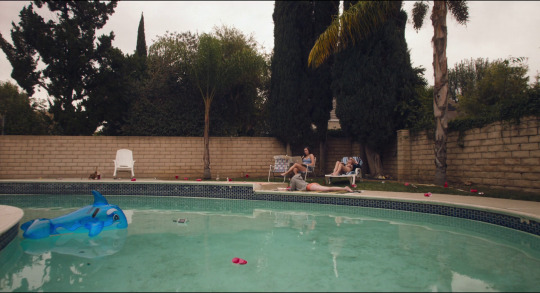


#240 Domestic studies: Palo Alto (2013)
#Palo alto#palo alto movie#gia coppola#james franco#emma roberts#jack kilmer#nat wolff#zoe levin#Summertime#summer movie#domestication#domestic studies
967 notes
·
View notes